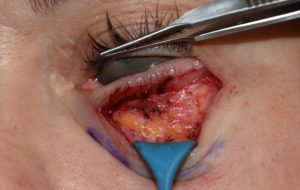Treatment of tear trough and under eye hollows has been revolutionized by the use of injection materials. Using either resorbable injectable fillers or fat taken from the patient, injection under the eyes can fill out sunken areas creating a rejuvenated appearance. Although there are advocates for either synthetic fillers and fat, both materials can have good success in the lower periorbital region.
While many patients have good improvement in their tear troughs and under eye hollows with injections, not all patients do. The under eye area is the most technique sensitive area of the face for any type of injection. The thin tissues of the lower eyelid reveal any asymmetries and irregularities of the injected material. This may not be apparent for several days or weeks when any swelling has subsided. In some cases too much volume ends up creating the appearance of lower eyelid ‘bags’ which the patient is swelling and will go away on its own.
Solving these lower eyelid injection materials is fairly straightforward with hyaluronic-based injectable fillers. Enzymatic digestion with hyaluronidase injections can rapidly remove any excess material. But this is not the case with other types of injectable fillers (e.g. Radiesse) and fat injections for which no reversal injections exist.

For those patients so afflicted with undereye contour problems from injected fat or particulated synthetic fillers, excision is the only effective treatment. Like all lower blepharoplasty procedures the subciliary and lateral canthal incision usually heal in an inconspicuous fashion.
Dr. Barry Eppley
Indianapolis, Indiana



